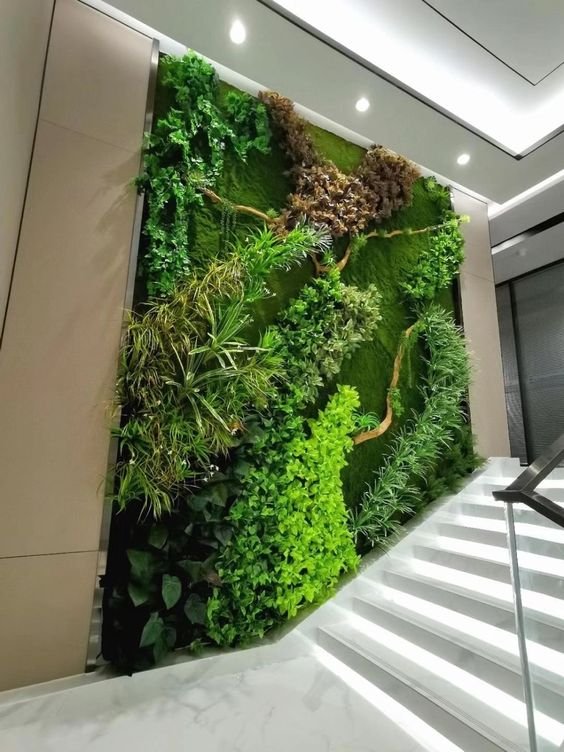Lorem ipsum dolor sit amet, consectetur adipiscing elit. Ut elit tellus, luctus nec ullamcorper mattis, pulvinar dapibus leo.
Introduction to Different types of vertical gardens:
In the fast-paced urban environments where housing is exceptionally valuable, gardening has become an art form that transcends geographical limitations. Discover the fascinating world of vertical gardens, an innovative way of growing vegetation that not only overcomes space limitations but also turns bare walls into vivid green canvases. With the help of this comprehensive guide, we will take a tour through all kinds of vertical gardening and discover how they elevate the beauty of the natural world.
We shall investigate several kinds of vertical gardens as we descend into this lush realm; each has a special allure and useful benefits. From the recognised living wall systems that transformed the aesthetics of architecture to fanciful hanging gardens that defy gravity, we’ll reveal the techniques for turning any area into a lush paradise.
However, vertical planting is more than just a decorative project. It’s a sustainable method that replenishes our lives with nature, improving biodiversity, improving air quality, and creating a heaven for the environment and our mental health. Come along as we break down all the different aspects of vertical gardening, providing you with knowledge, advice, and motivation to help you create your own little vertical garden.

1. Understanding Vertical Gardening:
Let’s first understand the conceptual framework of vertical gardening before exploring all kinds of these gardens. Such types of gardens are perfect for small urban spaces since they make effective use of vertical space, in contrast with traditional horizontal gardens. Through the use of walls, fences, or other specific structures, these gardens optimise available space, provide insulation, and enhance air quality.
2. Types of Vertical Gardens:
2.1. Living Wall Systems:
Green walls, or living wall systems, are probably the most renowned type. In these artworks, the vertical surfaces are directly grown with plants, which are held up by a framework that serves as structural, drainage, and irrigation support. Living walls offer variety in design and selection of plants and can range in size from modest do-it-yourself projects to broad, well designed installations.
2.2. Vertical Garden Towers:
Traditionally known to as garden columns, these freestanding structures are designed to hold various kinds of plants in a limited area. Planters can be mounted vertically in these towers as they often consist of numerous tiers or shelves. These types of garden towers provide a vertical paradise for veggies, flowers, or herbs and are perfect for patios, balconies, or interior areas.
2.3. Hanging Gardens:
Any surface might be created whimsical using hanging gardens, which create an appearance of a floating garden by suspending plants in midair. An endless number of innovative and customised choices are available to create hanging gardens, whether you choose to use vertical planters, macramé plant hangers, or recycled materials. The plants in hanging gardens, ranging from lush ferns to cascading vines, give spaces a lively, interesting appearance.
2.4. Trellis Systems:
Incorporating both practicality and style, trellis systems give outdoor spaces architectural appeal and support for climbing plants. Trellises provide an adaptable surface for vertical gardening, regardless of whether they are made of metal, wood, or recyclable materials. Trellis systems encourage vertical growth, from fragrant jasmine to sprawling grapevines, which creates a lovely backdrop for outdoor living spaces.
2.5. Modular Vertical Gardens:
Modular vertical gardens can be created in a variety of ways by utilising modular panels or containers. Because these systems are flexible in terms of installation and design, gardeners may modify their spaces to accommodate shifting tastes and environmental conditions. Modular gardens are a great option for urban dwellers since they are expandable, effective, and simple to manage whether they are situated indoors or outdoors.

3.Tips for Designing Vertical Gardens:
A vertical garden’s design must carefully take into account elements including plant selection, irrigation requirements, and sunlight exposure. The following guidelines will help you in developing a successful vertical garden:
- Analyse sunlight exposure: To choose the right plants for your garden, find out how much sunlight it receives.
- Select the correct plants: Choose plants that will suit your architectural scheme and grow well in vertical settings.
- Include irrigation: Maintaining ideal moisture levels and preventing water runoff requires effective irrigation.
- Think about structural support: Consider how well your garden installation can sustain the weight of the plants and soil.
- Accept your creativity: To build visually striking vertical landscapes, try experimenting with different plant layouts, textures, and colours.
4.Inspirational Vertical Garden Designs:
These inspiring garden designs from around the globe may perhaps spark your imagination:
- The lush gardens of CaixaForum Madrid, designed by Patrick Blanc, captivate visitors with their vibrant foliage and innovative design.
- The garden at One Central Park in Sydney, Australia, showcases a stunning array of native Australian plants, creating a green oasis amidst urban development.
- The Bosco Verticale (Vertical Forest) in Milan, Italy, epitomizes sustainable urban living, featuring two residential towers adorned with over 900 trees and 20,000 plants.
Conclusion:
It’s clear that these living landscapes offer more than simply a visual show as we come to the end of our tour through the numerous varieties and ideas that define vertical gardening—they serve as a link between urban living and the natural world. These kinds of gardens have transforming qualities; they are not just ornamental. They give seemingly lifeless places new vitality and transform them into vibrant ecosystems that benefit both our planet’s health and our own well-being. Thanks to the adaptability of living walls, garden towers, hanging gardens, trellis systems, and modular designs, anybody may enjoy the satisfaction of creating their own vertical sanctuary, even with limited space.
Remember that there are many advantages to vertical gardening beyond just aesthetics when you start your own project. These green spaces serve as a symbol of our dedication to preserving nature while residing in urban areas. Now go ahead and sow those seeds, tend to your vertical heaven, and observe as your area becomes a dynamic example of the harmonious coexistence of human inventiveness with the natural world. Vertical gardening is a lifestyle that celebrates green living and enhances your space and soul, not just a fad. Cheers to your wonderful gardening!


